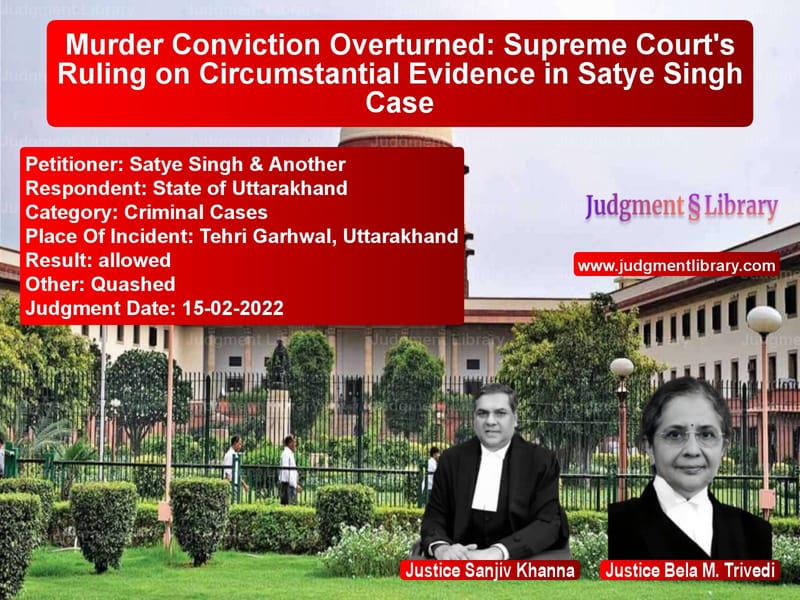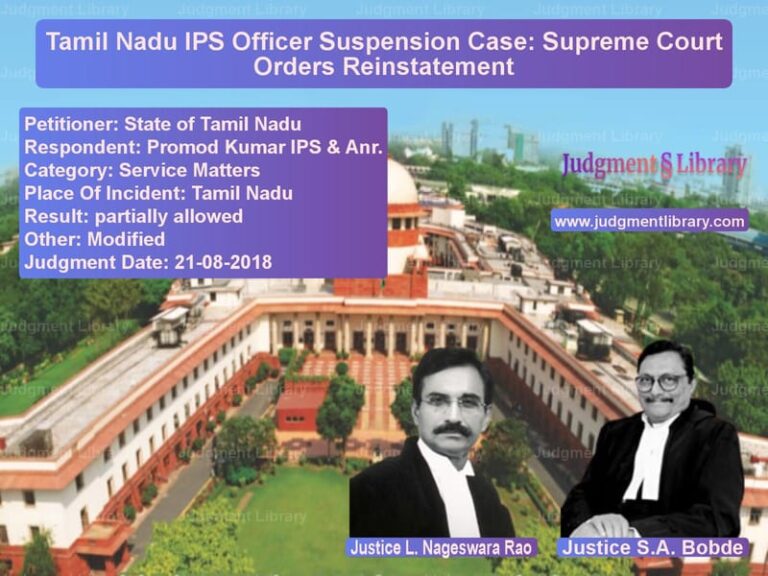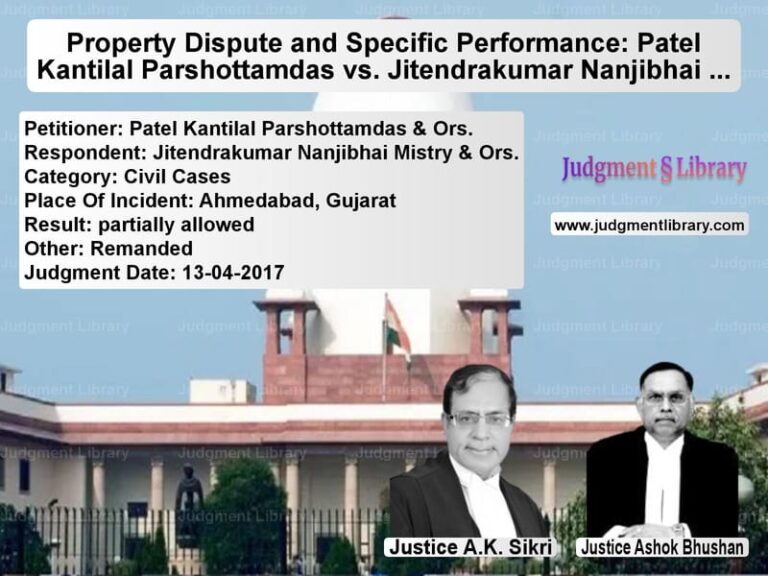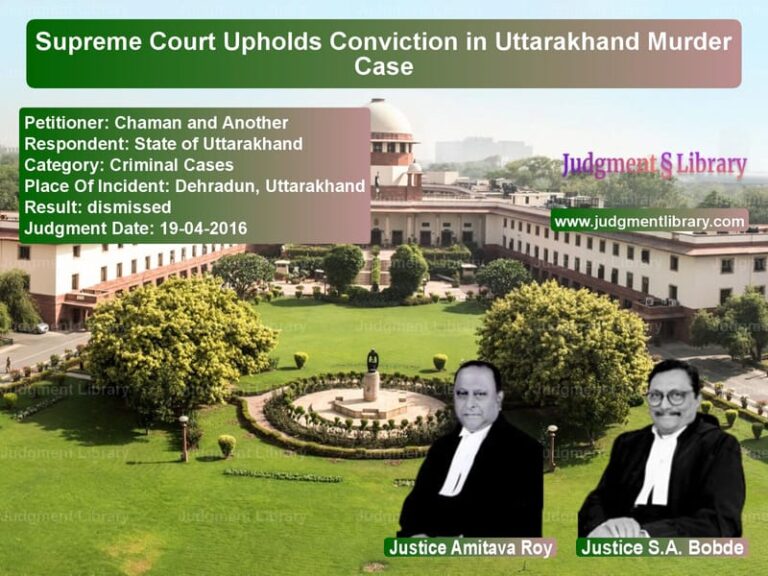Murder Conviction Overturned: Supreme Court’s Ruling on Circumstantial Evidence in Satye Singh Case
The case of Satye Singh & Another vs. State of Uttarakhand is a crucial ruling on the role of circumstantial evidence in criminal trials. The Supreme Court had to determine whether the conviction of the accused under Section 302 (murder) and Section 201 (causing disappearance of evidence) of the Indian Penal Code was valid despite the lack of direct eyewitness testimony. The Court ultimately acquitted the accused, emphasizing the need for a complete chain of circumstances to establish guilt.
This ruling has significant implications for criminal law, reinforcing that suspicion, however strong, cannot replace legal proof beyond a reasonable doubt.
Background of the Case
The case concerned the death of Shashi Devi, wife of the appellant Satye Singh. She was found dead due to burn injuries at her residence between the evening of 27th June 2009 and the morning of 28th June 2009. The police received a call about the incident from the village pradhan, and upon arrival, they found Shashi Devi’s body in a burnt condition.
Shashi Devi’s father, Sharad Singh, filed a complaint alleging that his daughter had been murdered by her husband, mother-in-law Indra Devi, and sister-in-law Sangeeta Devi. Based on his statement, the Revenue Police registered a case under Sections 302 and 201 IPC. The trial court convicted the accused, sentencing them to life imprisonment for murder and six years of rigorous imprisonment for destruction of evidence. The Uttarakhand High Court upheld this conviction.
The accused then appealed to the Supreme Court, challenging their conviction on the grounds that there was insufficient evidence linking them to the crime.
Legal Issues Before the Supreme Court
The core legal questions in the case were:
- Did the prosecution establish a complete chain of circumstantial evidence to prove the guilt of the accused?
- Was there credible evidence to show that the accused committed the murder?
- Could the accused be convicted based on the presumption under Section 106 of the Indian Evidence Act, which places the burden of explanation on a person having special knowledge of the facts?
Arguments Before the Supreme Court
Appellant’s Arguments
The appellants, represented by their legal counsel, argued:
- The conviction was based solely on circumstantial evidence, with no direct proof of their involvement in the crime.
- The trial court and High Court convicted them based on suspicion rather than concrete evidence.
- There was no forensic evidence, witness testimony, or independent investigation establishing their guilt.
- Under criminal law, the burden of proof lies with the prosecution, and the accused cannot be convicted merely for failing to explain a suspicious circumstance.
State’s Arguments
The State of Uttarakhand, representing the prosecution, argued:
- The accused were the last persons to be with the deceased before her death.
- There was a history of dowry harassment and domestic abuse.
- The accused failed to provide any explanation for the death of the victim.
- Even though the evidence was circumstantial, it was sufficient to establish guilt.
Supreme Court’s Judgment
The Supreme Court ruled in favor of the appellants, setting aside their conviction. The key findings were:
- The prosecution failed to establish a complete chain of circumstances proving that the accused alone were responsible for the murder.
- Although the victim’s injuries were determined to be ante-mortem (before death), the prosecution could not conclusively establish how they were caused or by whom.
- The accused’s failure to explain the circumstances of the victim’s death did not shift the burden of proof away from the prosecution.
- Mere suspicion, however strong, is not sufficient to convict an individual for murder.
The Supreme Court observed:
“It is settled law that suspicion, however strong it may be, cannot take the place of proof beyond a reasonable doubt. The prosecution must prove the guilt of the accused conclusively, and in the present case, it has failed to do so.”
Key Observations from the Judgment
- Convictions in criminal cases cannot be based on conjecture or incomplete evidence.
- For circumstantial evidence to be relied upon, it must form a continuous chain that leads to only one conclusion: the guilt of the accused.
- Section 106 of the Indian Evidence Act does not relieve the prosecution of its duty to prove the case beyond reasonable doubt.
- In cases of unexplained deaths, courts must be cautious and not convict merely on the basis of moral suspicion.
Impact of the Judgment
This ruling has significant implications for criminal law and the burden of proof:
- For Criminal Defendants: Reinforces the principle that the burden of proof always lies on the prosecution.
- For Law Enforcement: Highlights the need for thorough investigations before seeking convictions based on circumstantial evidence.
- For Trial Courts: Serves as a precedent that convictions should not be based on incomplete or inconsistent evidence.
- For Human Rights Advocates: Strengthens the principle that justice must be based on proof beyond reasonable doubt and not on public sentiment or suspicion.
Conclusion
The Supreme Court’s decision in Satye Singh & Another vs. State of Uttarakhand serves as an important precedent in criminal law, emphasizing the need for solid and unambiguous evidence in securing convictions. By setting aside a conviction based on incomplete circumstantial evidence, the ruling reinforces the fundamental principle that an accused is presumed innocent until proven guilty.
This judgment underscores that courts must remain vigilant against the dangers of convicting individuals based on mere suspicion. It serves as a reminder that due process and legal principles must always guide criminal trials to ensure justice is served.
Petitioner Name: Satye Singh & Another.Respondent Name: State of Uttarakhand.Judgment By: Justice Sanjiv Khanna, Justice Bela M. Trivedi.Place Of Incident: Tehri Garhwal, Uttarakhand.Judgment Date: 15-02-2022.
Don’t miss out on the full details! Download the complete judgment in PDF format below and gain valuable insights instantly!
Download Judgment: satye-singh-&-anothe-vs-state-of-uttarakhand-supreme-court-of-india-judgment-dated-15-02-2022.pdf
Directly Download Judgment: Directly download this Judgment
See all petitions in Murder Cases
See all petitions in Judgment by Sanjiv Khanna
See all petitions in Judgment by Bela M. Trivedi
See all petitions in allowed
See all petitions in Quashed
See all petitions in supreme court of India judgments February 2022
See all petitions in 2022 judgments
See all posts in Criminal Cases Category
See all allowed petitions in Criminal Cases Category
See all Dismissed petitions in Criminal Cases Category
See all partially allowed petitions in Criminal Cases Category







